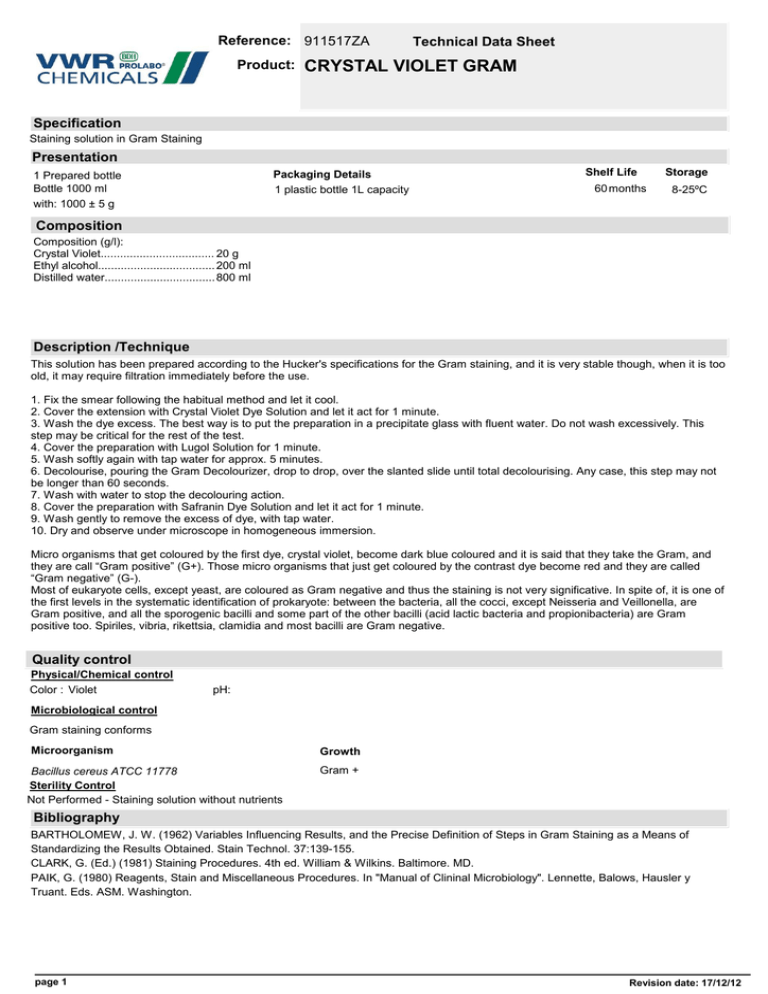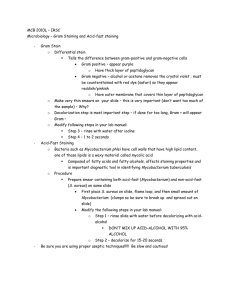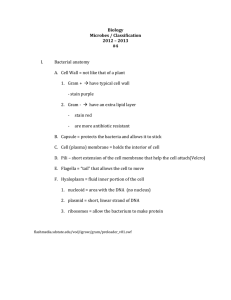crystal violet gram
advertisement

Reference: 911517ZA Product: Technical Data Sheet CRYSTAL VIOLET GRAM Specification Staining solution in Gram Staining Presentation Packaging Details 1 plastic bottle 1L capacity 1 Prepared bottle Bottle 1000 ml with: 1000 ± 5 g Shelf Life 60 months Storage 8-25ºC Composition Composition (g/l): Crystal Violet................................... 20 g Ethyl alcohol.................................... 200 ml Distilled water.................................. 800 ml Description /Technique This solution has been prepared according to the Hucker's specifications for the Gram staining, and it is very stable though, when it is too old, it may require filtration immediately before the use. 1. Fix the smear following the habitual method and let it cool. 2. Cover the extension with Crystal Violet Dye Solution and let it act for 1 minute. 3. Wash the dye excess. The best way is to put the preparation in a precipitate glass with fluent water. Do not wash excessively. This step may be critical for the rest of the test. 4. Cover the preparation with Lugol Solution for 1 minute. 5. Wash softly again with tap water for approx. 5 minutes. 6. Decolourise, pouring the Gram Decolourizer, drop to drop, over the slanted slide until total decolourising. Any case, this step may not be longer than 60 seconds. 7. Wash with water to stop the decolouring action. 8. Cover the preparation with Safranin Dye Solution and let it act for 1 minute. 9. Wash gently to remove the excess of dye, with tap water. 10. Dry and observe under microscope in homogeneous immersion. Micro organisms that get coloured by the first dye, crystal violet, become dark blue coloured and it is said that they take the Gram, and they are call “Gram positive” (G+). Those micro organisms that just get coloured by the contrast dye become red and they are called “Gram negative” (G-). Most of eukaryote cells, except yeast, are coloured as Gram negative and thus the staining is not very significative. In spite of, it is one of the first levels in the systematic identification of prokaryote: between the bacteria, all the cocci, except Neisseria and Veillonella, are Gram positive, and all the sporogenic bacilli and some part of the other bacilli (acid lactic bacteria and propionibacteria) are Gram positive too. Spiriles, vibria, rikettsia, clamidia and most bacilli are Gram negative. Quality control Physical/Chemical control Color : Violet pH: Microbiological control Gram staining conforms Microorganism Bacillus cereus ATCC 11778 Sterility Control Not Performed - Staining solution without nutrients Growth Gram + Bibliography BARTHOLOMEW, J. W. (1962) Variables Influencing Results, and the Precise Definition of Steps in Gram Staining as a Means of Standardizing the Results Obtained. Stain Technol. 37:139-155. CLARK, G. (Ed.) (1981) Staining Procedures. 4th ed. William & Wilkins. Baltimore. MD. PAIK, G. (1980) Reagents, Stain and Miscellaneous Procedures. In "Manual of Clininal Microbiology". Lennette, Balows, Hausler y Truant. Eds. ASM. Washington. page 1 Revision date: 17/12/12




